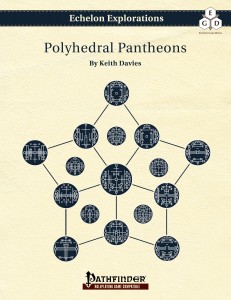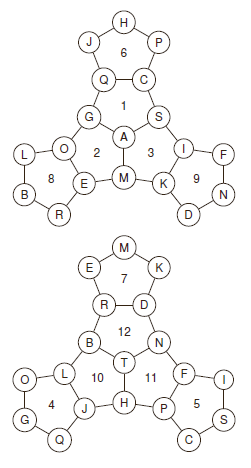
The elemental tetratheon is a pantheon for a larger, older culture that has discovered more concerns than the goblins. However, it is based on a small number of major gods, each with three aspects, and a slew of lesser gods that have narrower responsibilities.
Creating the Elemental Tetratheon
The polyhedral pantheon process can be summarized quite simply.
- Choose a polyhedron.
- Assign a domain to each point and face.
- Group domains for each god.
- Determine the ‘chosen weapon’ of each god.
This provides all the information needed to use the gods in play. There is no setting-specific information here, but it is enough for a cleric to choose her god and domains.
Let’s begin.
Step 1: Choose a Polyhedron
This time, I chose my second-favorite polyhedron, the dodecahedron, the d12.
This gives me thirty-two sites (twenty points and twelve faces) to assign domains to and to represent deities.
Step 2: Assign Domains to Each Point and Face

The diagram to the right presents the points (circled letters) and faces (numbered areas) of the polyhedron I am using.
I am deliberately placing the domains, choosing which domain will be assigned to each site. I have pretty specific ideas for some of the deities and this method gives me the most control.
In this pantheon I want to have the four elements as major powers. Each elemental domain will be assigned to a point such that no two faces share an elemental domain. I will do the same with the alignment domains, assigning each to a point such that no two faces share an alignment domain and such that each alignment domain is shared by three faces with different elemental domains.
The domains assigned to each face are:
- Sun
- Knowledge
- Nobility
- Animal
- Trickery
- Protection
- Death
- Plant
- Liberation
- Destruction
- Darkness
- Madness
The domains assigned to each point are:
- Fire
- Strength
- Glory
- Air
- Law
- Weather
- Artifice
- War
- Chaos
- Community
- Magic
- Earth
- Healing
- Travel
- Rune
- Water
- Good
- Repose
- Luck
- Evil
The only core domain skipped is the Charm domain. I can live without it.
Step 3: Group Domains for Each Deity
Alignment is initially determined primarily by domain assignment. Each deity’s primary domain is in bold text, domain-based alignments are (in parentheses).
- (NG) Sun, Fire, Glory, Artifice, Good, Luck
- (LN) Knowledge, Fire, Law, Artifice, Healing, Rune
- (CN) Nobility, Fire, Chaos, Magic, Healing, Luck
- (NG) Animal, Artifice, Community, Earth, Rune, Good
- (CN) Trickery, Glory, Weather, Chaos, Water, Luck
- (NG) Protection, Glory, War, Community, Water, Good
- (LN) Death, Air, Law, Magic, Healing, Repose
- (LN) Plant, Strength, Law, Earth, Rune, Repose
- (CN) Liberation, Air, Weather, Chaos, Magic, Travel
- (NE) Destruction, Strength, War, Community, Earth, Evil
- (NE) Darkness, Weather, War, Travel, Water, Evil
- (NE) Madness, Strength, Air, Travel, Repose, Evil
And the point deities:
- (TN) Fire, Sun, Knowledge, Nobility
- (TN) Strength, Plant, Destruction, Madness
- (TN) Glory, Sun, Trickery, Protection
- (TN) Air, Death, Liberation, Madness
- (LN) Law, Knowledge, Death, Plant
- (TN) Weather, Trickery, Liberation, Darkness
- (TN) Artifice, Sun, Knowledge, Animal
- (TN) War, Protection, Destruction, Darkness
- (CN) Chaos, Nobility, Trickery, Liberation
- (TN) Community, Animal, Protection, Destruction
- (TN) Magic, Nobility, Death, Liberation
- (TN) Earth, Animal, Plant, Destruction
- (TN) Healing, Knowledge, Nobility, Death
- (TN) Travel, Liberation, Darkness, Madness
- (TN) Rune, Knowledge, Animal, Plant
- (TN) Water, Trickery, Protection, Darkness
- (NG) Good, Sun, Animal, Protection
- (TN) Repose, Death, Plant, Madness
- (TN) Luck, Sun, Nobility, Trickery
- (NE) Evil, Destruction, Darkness, Madness
This gives me four deities of each element, and four deities of each partly-neutral alignment. This leaves me with sixteen deities with no element, and sixteen deities with no alignment. All twelve face deities have both element and alignment, and each deity with an elemental domain as primary domain is True Neutral. I may want to revisit this later, using the neighboring points and faces to adjust the domains. For now I won’t, though; this pantheon has a nice primal feel to it, where things are still pretty raw and without subtle shades of meaning.
Step 4: Determine the ‘Chosen Weapon’ of Each Deity
I am moving into the world building process next and I don’t need to know chosen weapons yet. I will skip this step for now and wait until I have a better feel for the deities and weapons that will suit their personalities rather than their domains.
Closing Comments
Because I had a clear idea where I wanted to go with many of my initial domains, and was happy to accept some unexpected results (Healing and Death in the same deity? Okay, I can do that) this step again took about an hour. The Excel worksheet I created saves me a lot of time.
I really like how this is coming, even this early. I might assign alignments to more deities using neighboring faces and points (but not assigning the alignment domains), but I have not yet decided.
Or I might go an alternate route. This structure lends itself to such possibilities as “lawful fire” and “chaotic water” as a replacement alignment system, and I might want to explore that.
In fact, in my next post I do some analysis of the domain groupings and alignments to see just what that looks like.
Pingback: Elemental Tetratheon, First Analysis | Keith Davies — In My Campaign - Keith's thoughts on RPG design and play.
Pingback: Halfling Pantheon, the Crunchy Bits | Keith Davies — In My Campaign - Keith's thoughts on RPG design and play.
Pingback: Earth Deities of the Tetratheon | Keith Davies — In My Campaign - Keith's thoughts on RPG design and play.
Pingback: Quick Update on Polyhedral Pantheons | Keith Davies — In My Campaign - Keith's thoughts on RPG design and play.
Pingback: Planar-Pantheon Analysis: Elemental Tetratheon | In My Campaign - Thoughts on RPG design and play